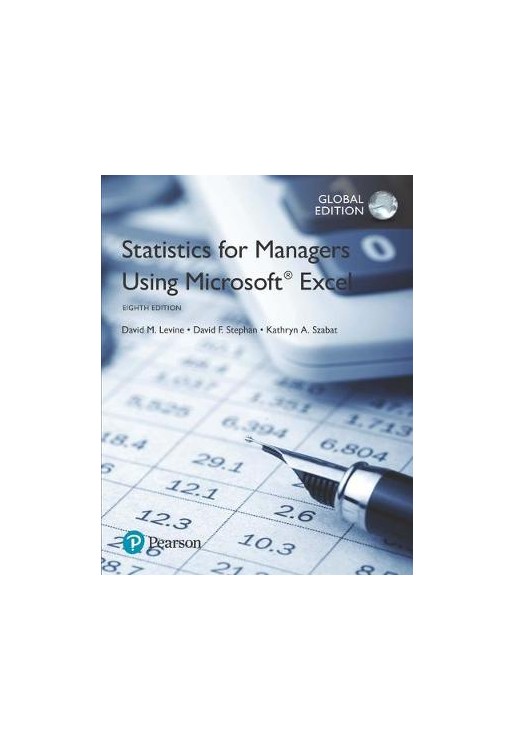


For undergraduate business statistics courses.
This package includes MyStatLab™.
Analyzing the Data Applicable to Business
This text is the gold standard for learning how to use Microsoft Excel® in business statistics, helping students gain the understanding they need to be successful in their careers. The authors present statistics in the context of specific business fields; full chapters on business analytics further prepare students for success in their professions. Current data throughout the text lets students practice analyzing the types of data they will see in their professions. The friendly writing style includes tips throughout to encourage learning.
The book also integrates PHStat, an add-in that bolsters the statistical functions of Excel.
This package includes MyStatLab™, an online homework, tutorial, and assessment program designed to work with this text to engage students and improve results. Within its structured environment, students practice what they learn, test their understanding, and pursue a personalized study plan that helps them absorb course material and understand difficult concepts.
MyStatLabshould only be purchased when required by an instructor. Please be sure you have the correct ISBN and Course ID. Instructors, contact your Pearson representative for more information.
First Things First
USING STATISTICS: “The Price of Admission”
FTF.1 Think Differently About Statistics
FTF.2 Business Analytics: The Changing Face of Statistics
FTF.3 Getting Started Learning Statistics
FTF.4 Preparing to Use Microsoft Excel for Statistics
REFERENCES
KEY TERMS
EXCEL GUIDE
1. Defining and Collecting Data
USING STATISTICS: Defining Moments
1.1 Defining Variables
1.2 Collecting Data
1.3 Types of Sampling Methods
1.4 Data Preparation
1.5 Types of Survey Errors
CONSIDER THIS: New Media Surveys/Old Sampling Problems
SUMMARY
REFERENCES
KEY TERMS
USING STATISTICS: Defining Moments, Revisited
CHECKING YOUR UNDERSTANDING
CHAPTER REVIEW PROBLEMS
CASES FOR CHAPTER
Managing Ashland MultiComm Services
CardioGood Fitness
Clear Mountain State Student Survey
Learning with the Digital Cases
CHAPTER 1 EXCEL GUIDE
2. Organizing and Visualizing Variables
USING STATISTICS: “The Choice is Yours”
2.1 Organizing Categorical Variables
2.2 Organizing Numerical Variables
2.3 Visualizing Categorical Variables
2.4 Visualizing Numerical Variables
2.5 Visualizing Two Numerical Variables
2.6 Organizing and Visualizing a Mix of Variables
2.7 The Challenge in Organizing and Visualizing Variables
USING STATISTICS: The Choice is Yours, Revisited
SUMMARY
REFERENCES
KEY EQUATIONS
KEY TERMS
CHECKING YOUR UNDERSTANDING
CHAPTER REVIEW PROBLEMS
CASES FOR CHAPTER
Managing Ashland MultiComm Services
Digital Case
CardioGood Fitness
The Choice is Yours Follow-Up
Clear Mountain State Student Survey
CHAPTER 2 EXCEL GUIDE
3. Numerical Descriptive Measures
USING STATISTICS: More Descriptive Choices
3.1 Central Tendency
3.2 Variation and Shape
3.3 Exploring Numerical Data
3.4 Numerical Descriptive Measures for a Population
3.5 The Covariance and the Coefficient of Correlation
3.6 Statistics: Pitfalls and Ethical Issues
SUMMARY
REFERENCES
KEY EQUATIONS
KEY TERMS
CHECKING YOUR UNDERSTANDING
CHAPTER REVIEW PROBLEMS
CASES FOR CHAPTER
Managing Ashland MultiComm Services
Digital Case
CardioGood Fitness
More Descriptive Choices Follow-up
Clear Mountain State Student Survey
CHAPTER 3 EXCEL GUIDE
4. Basic Probability
USING STATISTICS: Possibilities at M&R Electronics World
4.1 Basic Probability Concepts
4.2 Conditional Probability
4.3 Ethical Issues and Probability
4.4 Bayes’ Theorem
CONSIDER THIS: Divine Providence and Spam
4.5 Counting Rules
USING STATISTICS: Possibilities at M&R Electronics World, Revisited
SUMMARY
REFERENCES
KEY EQUATIONS
KEY TERMS
CHECKING YOUR UNDERSTANDING
CHAPTER REVIEW PROBLEMS
CASES DIGITAL CASE
CardioGood Fitness
The Choice is Yours Follow-Up
Clear Mountain State Student Survey
CHAPTER 4 EXCEL GUIDE
5. Discrete Probability Distributions
USING STATISTICS: Events of Interest at Ricknel Home Centers
5.1 The Probability Distribution for a Discrete Variable
5.2 Binomial Distribution
5.3 Poisson Dist